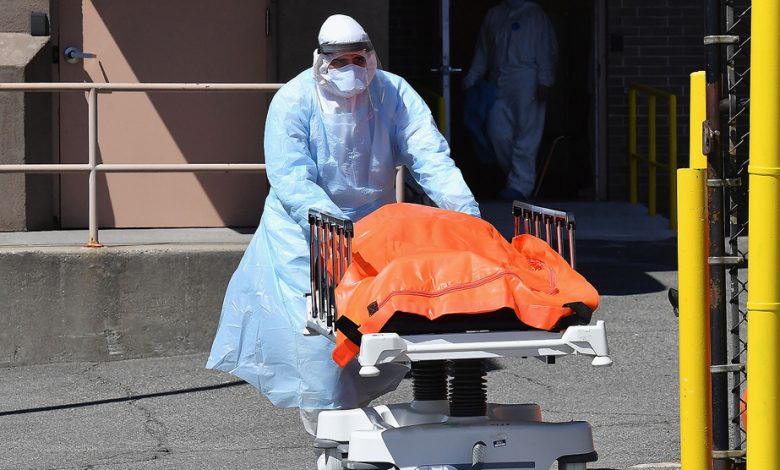COVID-19 updates: Mexico’s virus toll world’s third; Europe’s crisis accelerating

Mexico overtakes India with the third-highest number of coronavirus fatalities, after the US and Brazil. In Europe, countries consider imposing new restrictions as a new variant of COVID-19 that initially emerged in Britain, continues to rise across the continent.
Mexico surpassed India in coronavirus-related deaths, with 1,506 new fatalities on Thursday. The additional deaths pushed the total number of fatalities to 155,145 across the nation.
Mexico’s health ministry also reported 18,670 new confirmed cases of COVID-19, bringing the total number to 1,825,519 across the North American country.

In Mexico City, hospitals are nearing capacity and a shortage of oxygen tanks has complicated the treatment of patients.
India, a country with a population more than 10 times that of Mexico’s, has reported a total death toll of 153,847, according to a Reuters tally.
Mexican President Andres Manuel Lopez Obrador, who said he had tested positive for COVID-19 on Sunday, is now improving, according to Deputy Health Minister Hugo Lopez-Gatell.
The president has so far resisted imposing mandatory lockdowns to curb the spread of COVID-19.
New variant spreading in Europe
Europe is facing an accelerating health, economic, and political crisis. Amid high infection rates, hospitalizations, and deaths in many countries, the European economy remains largely in lockdown, more infectious virus variants are spreading.
French Health Minister Olivier Veran said Thursday the government’s current restrictive measures are becoming ineffective because the number of cases of the new variant of COVID-19 keeps steadily rising.
He said the new variant constituted 3.2% of total positive cases at the beginning of January, but that figure has increased to about one in 10 of all cases.
“From 500 cases then, we are today at more than 2,000 cases daily,” he said, adding that new variants of the virus are the worrying parameter as they “are more contagious.”

He warned about the emergence of “a pandemic within the pandemic” as the new variant of COVID-19 is circulating more widely and is “spreading faster every week.”
The effectiveness of the curfew is now “waning,” he added.
According to the latest figures, the number of new COVID-19 cases reached a record high of 26,916 by the end of Thursday evening. An additional 350 deaths were also reported.
The country, with a total number of 3,166,145 infection cases and 74,601 fatalities, has been under almost a year-long lockdown to combat the pandemic.
Government spokesman Gabriel Attal said the government is considering scenarios ranging “from maintaining the current framework to a very tight containment.”
This has raised the possibility of a third lockdown in less than 12 months in the county that “cannot take” restrictive measures anymore, according to the most recent opinion polls.
The country went into lockdown twice last year – the first between March and May and the second between October and December.
Fears of unrest
The French government is now cautious that a third lockdown could spark angry protests similar to what happened in the Netherlands this month.
Protests hit the Netherlands against coronavirus lockdown measures — the first ever curfew since World w War II — with the Dutch police using tear gas and water cannon to disperse protesters.
Police have arrested hundreds of people during days of unrest over the past two weeks in cities across the Netherlands, where protesters set fires and violently clashed with security forces.
Social media users in France have started calling for civil disobedience, using the hashtag “#JeNeMeReconfineraiPas” (#I will not go back into lockdown) on Twitter.
The United Kingdom has also seen several anti-lockdown protests as millions of people have long been living under restrictive measures.
Prime Minister Boris Johnson warned lately that tough measures may continue into the spring and even beyond.
Some 24 million people —representing 43% of the population — are currently living under lockdown in the UK.
Under the restrictions, non-essential shops, hairdressers and gyms remain closed. The order also includes a warning to stay at home, placing a limit on household mixing to two people outdoors.
The pandemic has so far infected a total number of 3,754,448 people and killed over 103,324 others across the UK, according to Johns Hopkins University.
According to the Foreign Policy magazine, Europe finds itself in an economically and politically explosive situation.
The continent, it said Friday, “will not be able to reopen its economy expeditiously, at least not without a ruinous death toll.”
“There will also not be any quick fixes in the coming weeks, as complex vaccine manufacturing capacity cannot be magically conjured up overnight.”
WHO experts in China’s Wuhan
Amid the crisis, the World Health Organization (WHO) launched an investigation into the origins of COVID-19 pandemic in the Chinese city of Wuhan on Friday.
The WHO sent a team of investigators to Wuhan, where the first ever coronavirus infection was reported in December 2019.
The team of experts met with a group of Chinese scientists in the central Chinese city ahead of a series of field visits to hospitals, laboratories and the now-closed Huanan market, which was said to have been linked to the first cases of the viral infection.
“All hypotheses are on the table as the team follows the science in their work to understand the origins of the COVID-19 virus,” the WHO said in a tweet.
It urged China to provide the team of investigators with “the support, access and data they need.”
Earlier this month, the WHO technical lead on the disease, Maria Van Kerkhove, said that world may never find “patient zero” in its search for the origins of the new coronavirus.
The emergence of the coronavirus in Wuhan has prompted the US and some of its allies to claim that the virus had originated in a lab in the Chinese city and blame China for the spread of the disease across the globe.
White House spokesperson Jen Psaki said on Wednesday that it was “imperative we get to the bottom” of how the virus appeared and spread worldwide.
She urged a “robust and clear” investigation into the origins of the pandemic, alleging that there might have been some “misinformation” from “some sources in China”.
Although the US had officially confirmed the first case of COVID-19 on January 19 — a man who had recently returned from China — a report said later that the coronavirus had infected people in the country weeks before it was officially identified in China.
The US Centers for Disease Control and Prevention (CDC) found that the virus was present in the US about a month earlier than public health authorities found the first case of COVID-19.
So far, the US has reported 25,762,918 cases of COVID-19 and 433,195 related deaths, according to Johns Hopkins University (JHU) which keeps data on the pandemic.
Beijing says it has already launched its own investigation into the origins of the pandemic that has claimed the lives of 2,191,078 people across the world.
The virus has so far infected more than 101,453,597 people worldwide.
China has, however, managed to effectively control the spread of the deadly disease, with a total number of 99,746 cases of the infection and 4,813 coronavirus related deaths across the mainland.
The US has warned that new, more contagious variants of the coronavirus will likely accelerate the spread of the virus across the country.
A new variant first identified in Britain, known as B.1.1.7, is being found in the US and elsewhere across the world.
It has so far been detected in at least 70 countries, according to the WHO’s weekly epidemiological report released on Wednesday.







